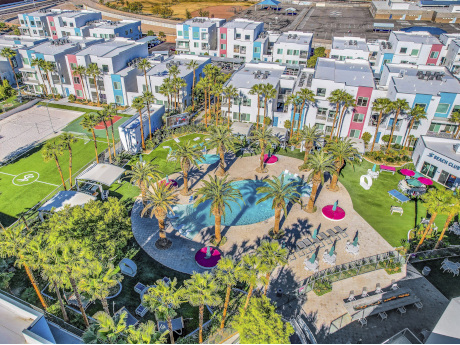By Adam Schmitt, First Vice President, CBRE | Multifamily Investment Properties
The multifamily construction pipeline in Las Vegas has ramped up in recent years and continues to be robust. Apartment developers have long capitalized on the growth of the Las Vegas market, and with the vast potential remaining in the city, multifamily builders are continuing to place their bets in Vegas. Our team at CBRE tracked a total of 4,317 multifamily units constructed in 2021, and are projecting more than 8,000 in 2022, with at least 16,000 in 2023 and beyond. For reference, over the past 10 years, the Las Vegas multifamily market has delivered about 3,700 annual units on average.
The projects being built in Las Vegas are predominately luxury, Class A developments that tend to cater to the lifestyle renter or renter-by-choice demographic. The locations of these developments are mostly concentrated in the Southwest and Henderson submarkets, comprising 62 percent of the construction pipeline. Developers
have historically flocked to these submarkets because of the areas’ respective demographics, perpetual growth and strong multifamily fundamentals. More recently, multifamily developers have found opportunities in the Northwest and North Las Vegas submarkets as those regions have seen years of high rent growth, and the rent levels are now making new projects feasible. About 26 percent of the construction pipeline resides in these two northern submarkets.
The Class A space (as well as the greater multifamily market in Las Vegas) has greatly benefitted from the relative lack of supply and accelerating prices from the single-family home market in the valley. Furthermore, Las Vegas has the fifth-lowest homeownership rate in the nation, providing for a higher propensity-to-rent demographic. Class A assets in Las Vegas exhibited 23.6 percent rent growth year over year as of the first quarter of 2022, while maintaining an average occupancy of 96.9 percent during 2021.
While the multifamily pipeline in Las Vegas is showing no signs of slowing, the single-family home construction remains low and job growth/recapture in Las Vegas is quickly accelerating. The ratio of job creation to residential supply is one of the most important metrics to gauge the overall health of the housing market in Las Vegas. In 2021, the market saw 3.22 jobs gained for every one unit of residential supply (both single-family and multifamily), which is a very encouraging indicator that the overall supply of housing in Las Vegas remains in balance.



